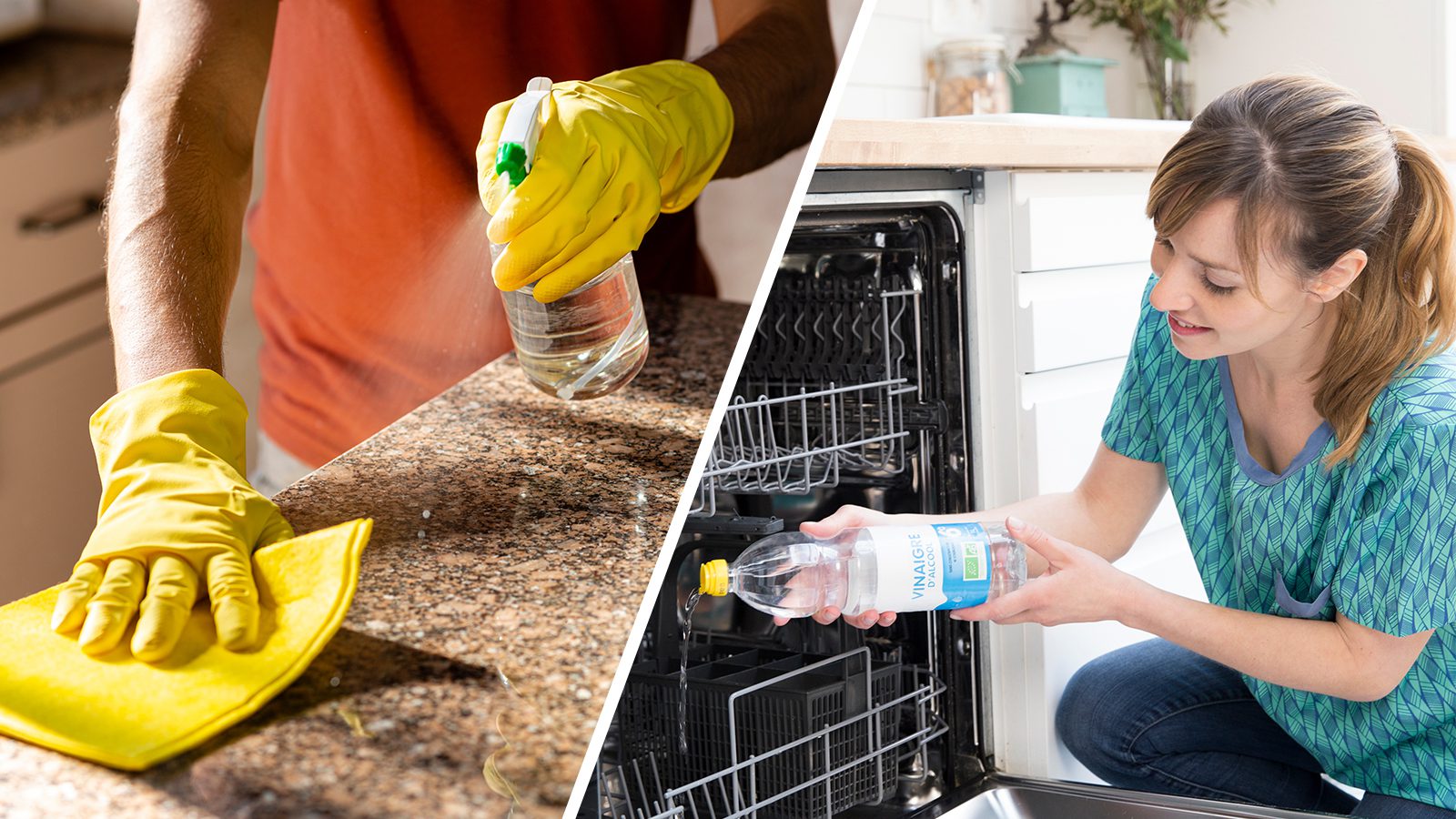You’ll be surprised at how much this natural cleaning agent can do…but proceed cautiously.
The hunt for natural, non-toxic, and inexpensive cleaning solutions has taken center stage in the pursuit of wellness. White vinegar, also known as distilled vinegar, has emerged as a leading contender among these cleaning solutions. This clear, pungent liquid, known for its acidity, has been touted as a ‘miracle cleaner’ for everything, from kitchen countertops to laundry stains.
However, as versatile as white vinegar can be, it’s essential to understand that it’s not a universal cleaning solution. Some surfaces and materials respond poorly to its acidity, leading to potential damage. At other times, its cleaning properties can work wonders.
Let’s look at what to clean with white vinegar and what to avoid. Knowing this information can ensure you can make the most out of this natural cleaner while safeguarding your precious items.
20 Things to Never Clean With White Vinegar
1. White Vinegar Can Damage Granite and Marble Countertops
While cleaning your granite or marble countertops with vinegar is tempting, you should refrain from doing so. Its high acid content can break down the sealant on your countertops, leading to dull spots known as “etches.” That can permanently damage your beautiful stone surfaces, leaving them vulnerable to further staining and damage. Use a pH-neutral cleaner specifically designed for stone surfaces for these precious countertops. This cleanser will keep them looking their best without potential harm.
2. Hardwood Floors
Hardwood floors, like stone countertops, require special care when cleaning. The acidity can deteriorate the finish on your hardwood floors, potentially causing them to look dull and leaving them open to further damage. Using a cleaner specifically formulated for hardwood is best for such delicate surfaces. These will clean effectively without damaging the protective coating or the wood underneath.
3. Irons
Your trusty iron might need cleaning, But vinegar should not be your go-to solution. Its acidity can corrode the internal parts of your iron, leading to potential malfunctions. Instead, following the manufacturer’s cleaning instructions or using a commercial iron cleaner designed for this purpose is always safer. These cleaners will effectively eliminate mineral build-up without damaging the delicate internal components of your iron.
4. White Vinegar Can Worsen Egg Stains or Spills
If you’ve ever tried cleaning an egg spill with vinegar, you probably discovered that it doesn’t work. The reason is simple: it causes the proteins in the egg to coagulate, essentially turning the spill into a semi-solid mass that is even harder to clean up. Instead, consider using a mild detergent or an enzymatic cleaner to break down the proteins and make the egg spill or stain easier to wipe away.
5. Pearls
Your precious pearls must be treated with the utmost care, and vinegar is too harsh for these delicate gems. The acetic acid dissolves the calcium carbonate in pearls, leading to a loss of luster and potentially changing their color. Instead, use a soft, clean cloth moistened with lukewarm soapy water to clean your pearls, preserving their natural beauty gently.
6. Smartphones and Laptops
While it’s a good idea to use vinegar to clean the screens of your smartphones and laptops, it’s best to avoid this method. The acid can strip away the protective coating on these screens, potentially causing them to look dull or even causing damage over time. Instead, use a soft, lint-free microfiber cloth or a cleaner specifically designed for electronics to clean these surfaces safely.
7. White Vinegar Damages Leather
Leather, whether a handbag, jacket, or piece of furniture, should never be cleaned with this product. The high acidity can dehydrate the leather, causing it to crack and deteriorate. Instead, opt for a specially designed leather cleaner or saddle soap, followed by a good quality leather conditioner to keep your leather items looking their best and prolong their lifespan.
8. Cast Iron Pans
Those who love their cast iron pans know that the seasoning on the pan is sacred. The high acid content can strip this seasoning off, leaving your pan as bare as the day you bought it. Instead, clean your cast iron pans with a soft sponge and warm, soapy water, then dry them thoroughly. Follow up by reseasoning them with a thin coat of oil to keep them in prime cooking condition.
9. White Vinegar Creates Rust on Aluminum
Although it is a fantastic cleaner for many things, it’s best to stick with warm, soapy water for aluminum. Vinegar can cause aluminum to oxidize, creating a dull appearance that can be hard to reverse. Simply using warm, soapy water and a soft cloth, you can effectively clean your aluminum items without causing any damage.
10. Waxed Furniture and Flooring
Like hardwood floors and leather, the wax finish on furniture and flooring can be stripped away by acidity. That can leave your surfaces looking dull and lifeless and can also leave them vulnerable to further damage. Instead, use a cleaning product specifically designed for waxed surfaces to keep them looking shiny and new. Always remember to follow the product’s instructions closely for the best results.
11. Certain Parts of Dishwashers and Washing Machines
While vinegar is often touted as a wonder cleaner for appliances, it can cause harm to certain parts of your dishwasher or washing machine. These machines often contain rubber parts, and the acetic acid can degrade these, leading to leaks or even part failures. Instead, use a product specifically designated for cleaning these appliances or follow the manufacturer’s instructions for safe and thorough cleaning.
While cleaning your appliances regularly can prevent issues, sometimes you may notice signs that indicate they need repair and maintenance. For instance, if your dishwasher starts making unusual noises or your washing machine leaks despite careful use, it’s wise to contact professionals for assistance. You can reach out for services like Travis County Appliance Repair, they are readily available to diagnose and fix these issues promptly. Attempting DIY repairs can sometimes worsen the problem or void warranties, so relying on experts ensures that your appliances receive proper care without compromising their functionality.
12. Grout
Although it may seem like a great idea to use vinegar to clean the grout between your tiles, it’s not. It can dissolve grout, especially if not sealed correctly, leading to damage and costly repairs. Instead, opt for a baking soda and water paste or a specially designed grout cleaner to safely clean these areas.
13. Brass and Bronze
Brass and bronze are two materials that acidity can damage. This can cause these metals to corrode, leading to permanent damage. Stick to using a brass or bronze cleaner to keep these surfaces in good condition and maintain their original shine.
14. Do Not Mix White Vinegar With Anything Containing Bleach
If you’re dealing with an item or surface treated or stained with bleach, it’s essential to steer clear of it for cleaning purposes. Mixing vinegar (or any acidic substance) and bleach is risky because it creates chlorine gas. This toxic substance can cause serious respiratory issues and eye irritation upon exposure.
The science behind this is straightforward. Bleach (sodium hypochlorite) reacts with acetic acid (the main component of vinegar) to produce chlorine gas. The chemical reaction can be summarized as follows:
NaClO (bleach) + 2 CH3COOH (vinegar) → Cl2 (chlorine gas) + 2 CH3COONa + H2O (water)
Chlorine gas, even in small quantities, can be harmful. It can severely impact the respiratory system, including a burning feeling in the eyes, nose, and throat or coughing. In severe cases, it may lead to difficulty breathing or lung fluid.
Thus, if you’re cleaning something with bleach, it’s safer to rinse with plenty of cold water and wash the item separately with a mild detergent. Always use gloves to protect your skin and ensure the area is well-ventilated. Avoid using this or any other acid-based cleaning agents on these items to ensure your safety and the safety of those around you.
15. Pets
Never use it to clean your pets. Its acidity can harm their skin and eyes, and ingesting it can cause health problems. Instead, use pet-friendly shampoos and cleaners for their grooming needs.
16. Suede
Suede is a delicate material that you would damage with white vinegar. The high acidity can cause discoloration and drying, leading to a rough texture. Always use a cleaner specifically designed for suede for these items.
17. Wax-Coated Items
Like waxed furniture and flooring, any wax-coated items should not be cleaned with vinegar. It can strip the wax, leaving the item vulnerable to damage. Instead, use a damp cloth and mild soap.
18. White Vinegar May Harm Antiques
Antiques, especially those with a patina, should never be cleaned with it. High acidity can strip the patina away and damage the underlying material. Always consult an expert or use products designed explicitly for antiques.
19. Certain Types of Painted Surfaces
Vinegar is a natural alternative to chemical paint strippers. Therefore, using it on painted surfaces may result in the paint stripping off. Always test a small, inconspicuous area first, or opt for a gentle, pH-neutral cleaner.
20. Stained or Unsealed Wood
While this natural cleanser is helpful on well-sealed or painted wood, others, especially stained ones, can be damaged. That’s because it can strip away the sealed finish and potentially alter the color of the stain. Instead, look for a cleaner specifically designed for stained wood surfaces.
20 Things That Are Safe to Clean With White Vinegar
1. White Vinegar Cleans Coffee Makers
This natural cleaning product is perfect for decalcifying and freshening up your coffee maker. Fill the machine’s reservoir with half water and half vinegar. Then run the machine halfway before letting it sit for about an hour. Afterward, finish the cycle and rinse thoroughly by running only a few cycles with water.
2. Microwave Ovens
The steam from vinegar water can loosen stubborn food stains and deodorize your microwave. Place a microwave-safe bowl filled with a mixture of one cup of water and one cup of vinegar inside. Microwave the mixture for about ten minutes, then quickly wipe down the interior.
3. Windows and Mirrors
Vinegar is an excellent streak-free cleaner for glass surfaces. Mix equal parts of vinegar and warm water in a glass or plastic spray bottle, spray onto the glass, and wipe with a microfiber cloth or crumpled newspaper.
4. White Vinegar Can Decalcify Shower Heads
Mineral build-up on your shower head can affect water flow. Remove the build-up by detaching the shower head and soaking it in a bucket of white vinegar for a few hours, then rinse and reattach.
5. Toilets
Pour a cup or two of this natural cleaning miracle to clean and deodorize your toilet bowl. Let it sit for at least thirty minutes (overnight, if possible). Scrub lightly with a toilet brush and flush.
6. Ceramic Tile
The acidity can cut through the grime on ceramic tiles. Mix one part vinegar to one part water and mop or wipe the surface clean.
7. White Vinegar Freshens the Garbage Disposal
Vinegar can freshen up your garbage disposal. Pour half a cup of vinegar into the disposal, let it sit for a few minutes, then rinse with cold water while the disposal runs.
8. Cutting Boards
Wooden or plastic cutting boards can be sanitized with vinegar. Wipe them down with full-strength vinegar after washing to keep them bacteria-free.
9. Refrigerators
Mix equal parts of vinegar and water. You’ll make a non-toxic and deodorizing fridge cleaner. Use this solution to wipe down the interior shelves and walls.
10. Stovetops and Ovens
A vinegar and baking soda mixture will scrub stubborn grease and grime on stovetops and ovens. Apply the paste, let it sit for a few minutes, then wipe clean.
11. White Vinegar Shines Stainless Steel
This natural cleaning agent works wonders on stainless steel surfaces. Dab a cloth in vinegar and wipe your appliances for a streak-free shine. Be sure to wipe in the direction of the grain for the best results.
12. Carpet Stains
Vinegar can be a savior when dealing with stubborn carpet stains. Mix two tablespoons of salt with a half of a cup of vinegar. Then apply the solution to the stain, let it dry, and vacuum. For tougher stains, add two tablespoons of borax to the mix.
13. Pet Urine
If your pet has had an accident, vinegar can help. Blot up as much of the urine as possible. Next, apply a solution of equal parts water and vinegar. Blot again, rinse with warm water and let dry. It will help neutralize the smell.
Do not let your pet revisit the area until the smell of the white vinegar has completely dissipated and the carpet dries.
14. White Vinegar Can Neutralize Most Mildew
Vinegar is a natural fighter against mildew. Spray it undiluted onto the mildew, let it sit for a few hours, then scrub with a brush and rinse with warm water.
15. Scissors
Instead of water that can rust them, use it to clean off the sticky residue from the scissors. Dip a cloth in it (undiluted) and wipe the blades clean.
16. Paint Brushes
To soften paint brushes, soak them in a mixture of hot vinegar and soap for a few minutes, rinse with warm water, and let dry.
17. Drains
It can be used to unclog and freshen drains. Pour a large handful of baking soda down the sink drain, add half a cup of vinegar, and rinse with hot water after fifteen minutes.
18. White Vinegar Can Be a Fruit Fly Trap
To get rid of pesky fruit flies, fill a bowl with a small amount of vinegar, cover it with a small piece of plastic wrap and poke little holes in it. The fruit flies will find it impossible to resist and become trapped under the plastic.
19. Shower Curtains
Machine wash your shower curtain with a towel to remove mildew and soap build-up from shower curtains. Add half a cup of detergent and half a cup of vinegar to the load. Rinse it thoroughly and let it dry.
20. Laundry Brightener and Fabric Softener
Add half a cup of vinegar to your wash cycle to brighten up your laundry. It is also an incredibly effective fabric softener. Add it to the washing machine’s fabric softener dispenser, and your clothes will come out soft and static-free.
Seven Benefits of Cleaning With White Vinegar When It’s Safe for the Surface
Antibacterial properties: Multiple studies prove that white vinegar can kill many bacteria. Acetic acid, the active compound in vinegar, can dissolve the cell membranes of bacteria, effectively killing them. It makes it a natural alternative to harsh chemical disinfectants.
- Non-toxic: Unlike many commercial cleaning products, vinegar doesn’t emit volatile organic compounds (VOCs) or other potentially harmful substances. That can improve indoor air quality and is safer for those with allergies, asthma, COPD, or chemical sensitivities.
- Effectively removes certain types of stains: The acidic nature of white vinegar makes it a great natural stain remover for certain types of stains. It’s particularly effective on organic stains like coffee, tea, and sweat.
- Natural deodorizer: The acidity also neutralizes alkaline odors, which can help freshen up your home. After evaporating, it removes the neutralized odors, leaving a clean, fresh area behind.
- Effectively removes mildew: The acidity can kill most mold species, making it a natural choice for dealing with mildew and mold around your home.
- Descales appliances: The acetic acid makes it great for dissolving mineral deposits, making it a good choice for descaling appliances like kettles and coffee makers.
- Environmentally friendly: This natural cleaning product is biodegradable and doesn’t harm the environment, unlike many chemical cleaners.
However, despite these benefits, it’s important to remember that vinegar isn’t suitable for all surfaces and materials and is not highly effective at killing viruses. Always use it wisely and as part of a broader cleaning and disinfection strategy.
Final Thoughts on How to Use White Vinegar for Cleaning Your Home
White vinegar is hard to beat when it comes to practical, non-toxic, and economical home cleaning solutions. With its acetic acid content, white vinegar possesses potent antibacterial properties, making it an excellent alternative to harsh chemical cleaners. It can tackle myriad tasks, from deodorizing and removing stubborn stains to brightening your laundry and clearing drains.
Using white vinegar as a primary cleaning agent ensures a cleaner, healthier living space and contributes to a safer environment by reducing the number of chemicals released into our ecosystems. It’s a win-win choice that harmonizes well with a green, plant-based, and eco-conscious lifestyle.
However, while versatile, it’s crucial to remember that this natural cleansing agent is not a universal cleaner. As highlighted earlier, acidity can damage some materials and surfaces. Understanding where not to use vinegar is just as important as knowing where to use it, ensuring you can leverage its cleaning power without causing unwanted damage.
White vinegar is a star player in eco-friendly, natural cleaning solutions. Used wisely, it’s a formidable ally in your quest for a sparkling, fresh, and positive home environment. Keep this guide handy, and embrace the potential of it for cleaning your home—nature’s way.

















 Community
Community

